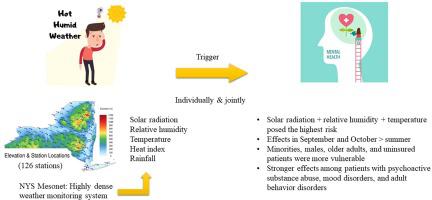Environment International ( IF 10.3 ) Pub Date : 2022-07-14 , DOI: 10.1016/j.envint.2022.107411 Xinlei Deng 1 , Jerald Brotzge 2 , Melissa Tracy 3 , Howard H Chang 4 , Xiaobo Romeiko 1 , Wangjian Zhang 5 , Ian Ryan 1 , Fangqun Yu 6 , Yanji Qu 7 , Gan Luo 6 , Shao Lin 8

|
Background
Mental disorders (MDs) are behavioral or mental patterns that cause significant distress or impairment of personal functioning. Previously, temperature has been linked to MDs, but most studies suffered from exposure misclassification due to limited monitoring sites. We aimed to assess whether multiple meteorological factors could jointly trigger MD-related emergency department (ED) visits in warm season, using a highly dense weather monitoring system.
Methods
We conducted a time-stratified, case-crossover study. MDs-related ED visits (primary diagnosis) from May-October 2017–2018 were obtained from New York State (NYS) discharge database. We obtained solar radiation (SR), relative humidity (RH), temperature, heat index (HI), and rainfall from Mesonet, a real-time monitoring system spaced about 17 miles (126 stations) across NYS. We used conditional logistic regression to assess the weather-MD associations.
Results
For each interquartile range (IQR) increase, both SR (excess risk (ER): 4.9%, 95% CI: 3.2–6.7%) and RH (ER: 4.0%, 95% CI: 2.6–5.4%) showed the largest risk for MD-related ED visits at lag 0–9 days. While temperature presented a short-term risk (highest ER at lag 0–2 days: 3.7%, 95% CI: 2.5–4.9%), HI increased risk over a two-week period (ER range: 3.7–4.5%), and rainfall hours showed an inverse association with MDs (ER: −0.5%, 95% CI: 0.9-(-0.1)%). Additionally, we observed stronger association of SR, RH, temperature, and HI in September and October. Combination of high SR, RH, and temperature displayed the largest increase in MDs (ER: 7.49%, 95% CI: 3.95–11.15%). The weather-MD association was stronger for psychoactive substance usage, mood disorders, adult behavior disorders, males, Hispanics, African Americans, individuals aged 46–65, or Medicare patients.
Conclusions
Hot and humid weather, especially the joint effect of high sun radiation, temperature and relative humidity showed the highest risk of MD diseases. We found stronger weather-MD associations in summer transitional months, males, and minority groups. These findings also need further confirmation.
中文翻译:

使用高分辨率天气监测系统确定太阳辐射、温度、湿度和降雨持续时间对引发精神障碍的联合影响
背景
精神障碍 (MDs) 是导致严重痛苦或个人功能受损的行为或精神模式。以前,温度与 MD 相关,但由于监测地点有限,大多数研究都存在暴露错误分类。我们旨在使用高密度天气监测系统评估多种气象因素是否可以在温暖季节联合触发与 MD 相关的急诊科 (ED) 就诊。
方法
我们进行了时间分层的病例交叉研究。从纽约州 (NYS) 出院数据库获得 2017 年 5 月至 2018 年 10 月与 MDs 相关的 ED 就诊(初步诊断)。我们从 Mesonet 获得了太阳辐射 (SR)、相对湿度 (RH)、温度、热指数 (HI) 和降雨量,Mesonet 是一个实时监测系统,横跨纽约州大约 17 英里(126 个站点)。我们使用条件逻辑回归来评估天气-MD 关联。
结果
对于每个四分位距 (IQR) 的增加,SR(超额风险 (ER):4.9%、95% CI:3.2–6.7%)和 RH(ER:4.0%、95% CI:2.6–5.4%)均显示最大延迟 0-9 天 MD 相关 ED 就诊的风险。虽然温度存在短期风险(滞后 0-2 天的最高 ER:3.7%,95% CI:2.5-4.9%),但 HI 在两周内增加了风险(ER 范围:3.7-4.5%),和降雨小时数与 MD 呈负相关(ER:-0.5%,95% CI:0.9-(-0.1)%)。此外,我们在 9 月和 10 月观察到 SR、RH、温度和 HI 之间存在更强的关联。高 SR、RH 和温度的组合显示 MDs 的最大增加(ER:7.49%,95% CI:3.95–11.15%)。对于精神活性物质的使用、情绪障碍、成人行为障碍、男性、西班牙裔、非裔美国人、46-65 岁的个体,天气与 MD 的关联更强,
结论
湿热天气,尤其是高太阳辐射、温度和相对湿度的共同作用,显示出MD疾病的最高风险。我们在夏季过渡月份、男性和少数群体中发现了更强的天气-MD 关联。这些发现还需要进一步证实。









































 京公网安备 11010802027423号
京公网安备 11010802027423号